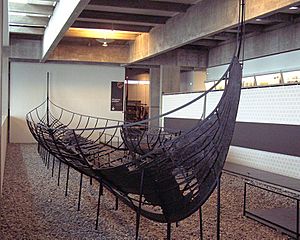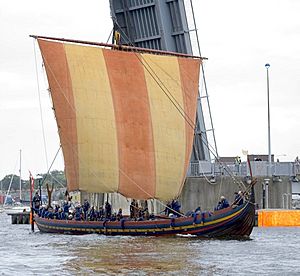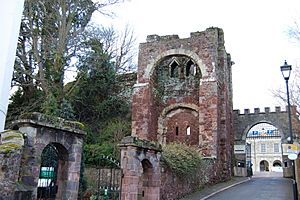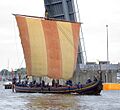Battle of Northam facts for kids
Quick facts for kids Battle of Northam |
|||||||
|---|---|---|---|---|---|---|---|
| Part of Norman Conquest of England | |||||||
|
|||||||
| Belligerents | |||||||
| Anglo-Saxons | Normans | ||||||
| Commanders and leaders | |||||||
| Godwin, Edmund | Brian of Brittany William De Vauville |
||||||
| Strength | |||||||
| unknown | unknown | ||||||
| Casualties and losses | |||||||
| 1,700 | unknown, lower | ||||||
The Battle of Northam was actually two battles fought on the same day in 1069. They took place near Northam in Devon, England. The battles were between a Norman army, led by Brian of Brittany, and an Anglo-Saxon army. The Saxon forces were commanded by Godwin and Edmund. These two were sons of the late English king, Harold Godwinson. The Normans won, causing many Saxon deaths and forcing them to leave Devon.
Contents
Why the Battle Happened
On October 14, 1066, a very important battle took place: the Battle of Hastings. In this battle, the English king, Harold Godwinson, was defeated and killed. The winner was the Duke of Normandy, who became known as William the Conqueror.
Even though William won the Battle of Hastings, it took him several years to fully control England. He faced many rebellions and small fights across the country. Places like Dover, Exeter, York, and Peterborough saw resistance. William didn't have enough soldiers to control all parts of England, especially in the north and west.
Because William's control was not complete, many members of King Harold's family kept fighting against the Normans. This included Harold's mother, Gytha, and his sons, Godwin, Edmund, and Magnus. They wanted to take back the throne.
Before the Fight
In 1067, some small uprisings happened in places like the Welsh Marches and Dover. King William managed to stop these without much trouble. But in early 1068, things got more serious in the west of England. The people of Exeter rebelled against William.
King William himself led an army to Exeter. He probably did this because Harold's mother, Gytha, and other family members were living there. William's army, which included some English soldiers, surrounded the city of Exeter. After 18 days, the city gave up. Gytha managed to escape.
The Anglo-Saxon Chronicle, a historical record, mentioned this event for the year 1067:
This year Harold's mother, Githa, and the wives of many good men with her, went to the Steep Holmes, and there abode some time; and afterwards went from thence over sea to St. Omer's.
While William was busy at Exeter, Harold's three sons – Godwin, Edmund, and Magnus – launched an invasion. They sailed from Ireland with a fleet of 52 ships. The ships were provided by Diarmait, the High King of Ireland. He had helped their father before.
By the time the sons arrived in Devon, King William had left. However, he had left a strong force to protect the area. This defending force was led by Eadnoth the Staller. Eadnoth fought against Harold's sons at Bleadon in Somerset. We don't know the exact result of this battle, but Eadnoth was killed. The Saxons then went back to their ships. After this battle, Magnus is not mentioned in any historical records, so his fate is unknown. The Saxons continued to raid the coasts of Devon and Cornwall before returning to Ireland with their stolen goods.
The Battles of Northam
In June 1069, Godwin and Edmund returned to England. They had an army with more than sixty ships. They landed at Appledore, a small village on the north Devon coast. From there, they moved towards Northam and started raiding the area.
This is likely where the first battle of the day took place. The Norman army, led by King William's second cousin, Brian of Brittany, and the noble William De Vauville, quickly arrived and attacked the Saxons.
The Anglo-Saxon Chronicle, Manuscript D, describes it:
After this came Harold’s sons from Ireland, at Midsummer, with 64 ships into the mouth of the Taw, and there heedlessly landed; and Earl Brian [Brian of Brittany] came against them unawares with no small band, and fought against them.
We don't know the exact size of either army. However, Brian of Brittany had a group of Breton knights. Other sources suggest that William De Vauville was the Sheriff of Devon. A sheriff was in charge of calling up the local Anglo-Saxon soldiers, known as the Fyrd. This might explain why the Normans had more soldiers than Godwin and Edmund.
The Saxon raiders were quickly pushed back to Appledore. There, they joined the rest of their army. They found that their ships were stuck because the tide was out. The soldiers had to stay and fight a second battle while they waited for the high tide to return.
For many hours, the Normans repeatedly attacked the Anglo-Saxon shield wall. This was similar to how the early parts of the Battle of Hastings had unfolded. The Saxon line held strong and did not break. However, they suffered many casualties. As night fell, the tide finally came in. The Saxons were able to escape to sea, and the battle ended.
What Happened Next
According to a historian named William of Jumièges, the Saxons lost 1,700 men. The Anglo-Saxon Chronicle said that the survivors fled to their ships, having lost their best fighters. None of Harold's sons were reported killed. It is believed they returned to Ireland. There, Diarmat told them he could not or would not give them more soldiers.
The brothers then went to Denmark. They might have hoped to get help from King Sweyn II Estridsson. However, it seems this help never came, as the brothers soon disappeared from history.
Another historian, Orderic Vitalis, wrote that after the battle, Exeter surrendered. A castle was built there. William the Conqueror then led his army into Cornwall. He "put down every disturbance that came to his attention." The Battle of Northam was the last major attempt by Harold Godwinson's sons to reclaim the throne of England.
Images for kids







